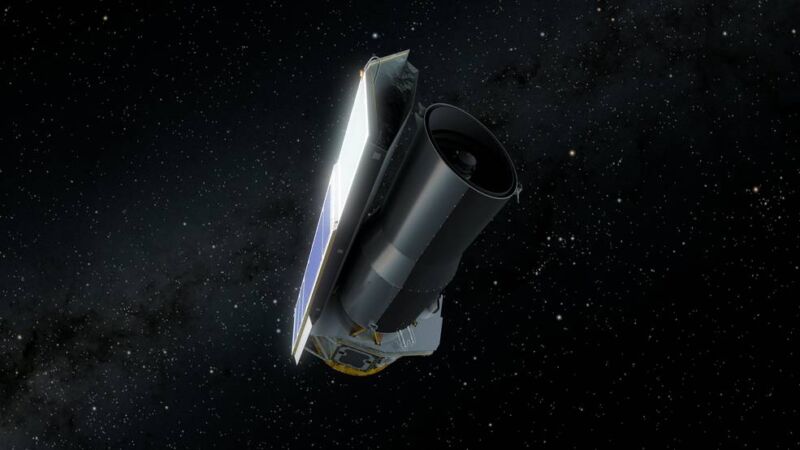
A Delta II rocket launched the Spitzer Space Telescope two decades ago, boosting it to an Earth-trailing orbit, where it drifted away from our planet at a rate of about 15 million kilometers a year. It was the last of NASA's four "Great Observatories" put into space from 1990 to 2003.
Over its planned five-year lifetime, the infrared space telescope performed its job well, helping astronomers discover newly forming stars, observe exoplanets, and study galaxies. After more than seven years, as anticipated by scientists, the onboard supply of liquid helium ran out. Without this coolant, some of Spitzer's scientific instruments were unavailable. So its operators switched to "warm mission" mode, taking data from two of its shortwave channels.
The space telescope continued operating until about three years ago, when the spacecraft began to overheat whenever it needed to point back toward Earth for communications. By this time, as it drifted farther from Earth, it was close to being on the opposite side of the Sun. This meant that operating the telescope, and having it phone home from time to time, would irreparably damage Spitzer's remaining scientific instruments.
And so in January 2020, after more than 16 years of service, the Spitzer Space Telescope was deactivated—consigned to drift in a heliocentric orbit until the Sun's fiery expansion at the end of its life a few billion years from now.
Or was it?
A small space technology company, Rhea Space Activity, says it has a plan to resurrect Spitzer. Last week the firm said it won a $250,000 grant from the US Space Force to continue studying a robotic rescue mission for the spacecraft, which is now about two astronomical units—or twice the distance of Earth from the Sun—away.
The plan is rather audacious, but it has some serious backers, including the Smithsonian Astrophysical Observatory, the Johns Hopkins University Applied Physics Laboratory, Blue Sun Enterprises, and Lockheed Martin.
"When it comes to robotic space servicing, this would be the most ambitious thing ever done," said Shawn Usman, an astrophysicist who is the founder and chief executive of Rhea Space Activity, in an interview with Ars. "I mean, it is literally sending a satellite to the other side of the Sun to resurrect the last Great Observatory. So I think it would be pretty ambitious, but it'd be really great if we could pull it off."
The "Spitzer Resurrector" mission would be a small spacecraft that could fit into a 1-meter-by-1-meter box and be ready to launch as soon as 2026, Usman said. It would then take about three years to cruise to the telescope, during which time the spacecraft will make observations of solar flaring.
"We plan to be busy right from the start of the mission," said Howard Smith, an astronomer at the Center for Astrophysics, which is operated by Harvard University and the Smithsonian, who is involved in the proposed rescue flight.
Once the resurrector spacecraft reaches the telescope, it would fly around at a distance of 50 to 100 km to characterize Spitzer's health. Then it would attempt to establish communications with the telescope and begin to relay information back and forth between the ground and telescope. This would allow scientists to restart observations.
Rhea Space Activity, which is named after the Greek goddess and presently has fewer than 10 employees, is seeking a larger grant from the military and, ultimately, full funding for a mission expected to cost about $350 million.
"It's a very beautiful collaboration between a private space company, academic research institutions, and the US Space Force," said Giovanni Fazio, a Harvard University astronomer who was the principal investigator of the Infrared Array Camera on Spitzer.
Commercial servicing
The effort by Rhea Space is part of an emerging trend in the commercial space industry. Northrop Grumman has been developing and launching a series of "mission extension" vehicles to service satellites in geostationary orbit. Billionaire Jared Issacman is working with SpaceX and NASA to use a Crew Dragon vehicle to extend the life of the Hubble Space Telescope.
The autonomous satellite technology developed by Rhea Space could have multiple applications for moving and servicing satellites in low-Earth and geostationary orbit. It is for these in-space servicing, assembly, and manufacturing capabilities that the Department of Defense is interested. Last year the White House published a report stating that advancing government and commercial capabilities in these areas was a priority for the United States.
Usman said the company has already had discussions with NASA about the mission, and the agency is likely to sign off on a rescue attempt. The space agency would welcome the return of Spitzer not only for scientific purposes, but also to help characterize the threat of near-Earth asteroids.
But is Spitzer healthy after all this time? Two decades have passed since Spitzer launched, and the Resurrector mission will not reach it before the end of this decade.
"The solar cells may be degraded, and there may be meteorite impacts," Fazio said. "So it's an uncertainty what condition the telescope is in. But our best estimate is that it will still be in an operating condition."
reader comments
173